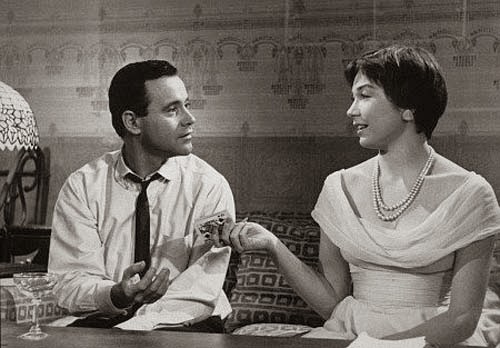
.jpg)
If you have never seen this film, please borrow it from the library and watch it. The characters are vibrant, the action is exciting, and the songs are memorable. You may not like the way the gangs dance around town; my wife actually hates it because she thinks it is too artificial. I think it is stylized and symbolic, like most ballets, and I can appreciate the sheer workmanship required for the "Prologue" dance to work. If you agree with my wife, however, skip the first five minutes and watch the film from where the story actually starts. All of the rest of the dancing and singing is more "natural," if I may use that term. Hating the way the gangs jump and snap their fingers to the music shouldn't prevent you from appreciating the rest of the film. The dance in the gymnasium, for example, is a simple high school dance, just choreographed to perfection. "I Feel Pretty" and "The Jet Song" and "America" are just the characters bursting with energy. They are staged just like any other Broadway musical song-and-dance number. The "Prologue" may seem stylized, but these other numbers seem "natural" in the sense that they could have occurred in films like An American In Paris or Gigi. Or maybe that's just me.
This production was co-directed by Robert Wise and Jerome Robbins. Robbins was the creative force behind the original Broadway show, and was hired to choreograph the dance sequences for the film. He is responsible for the entire "Prologue" and "Cool" sequences. He was such a perfectionist, however, that the producers fired him before the movie was complete. Robert Wise had to complete everything, including the remaining dance sequences. Luckily all of the dances had already been choreographed, so it is still mostly Robbins' vision that made it on to the screen.

I think the actors are all uniformly excellent. Natalie Wood as Maria is not only beautiful but totally believable as Maria. She has the most work to do during the film, starting as naive and virginal but ending as strong and forceful. I'm surprised she was not nominated for an Oscar. Richard Beymer as Tony has less screen presence, and although he is totally believable as the gosh-dern lover of Maria, it's harder to see the deep strength that he had to have had to start the Jets in the first place. Russ Tamblyn as Riff, the leader of the Jets, does have that certain presence, though. There is something about him so that whenever he is on screen your eye just naturally follows him. Rita Moreno as Anita and George Chakiris as Bernardo both won Best Supporting Oscars for their roles.


Of the 34 Best Pictures I have reviewed so far, West Side Story and Casablanca are my all-time favorites. If you haven't already done so, please see this film.
West Side Story
*Academy Award Best Picture of 1961*
Produced by Robert Wise
Directed by Robert Wise and Jerome Robbins
Directed by Robert Wise and Jerome Robbins
Screenplay by Ernest Lehman
Music by Leonard Bernstein
Lyrics by Stephen Sondheim
Choreographed by Jerome Robbins
Based on the Broadway show
produced by Robert E. Griffith & Harold S. Prince
Book by Arthur Laurents
Play conceived, directed, and choreographed by
Jerome Robbins
I couldn't find a trailer that didn't mention the 10 Academy Awards
so I picked this one. It looked newer, but it features more of the whole overall feel.
so I picked this one. It looked newer, but it features more of the whole overall feel.
Also Nominated:
(in alphabetical order)
Fanny
The Guns of Navarone
The Hustler
Judgment at Nuremburg
I have seen Judgment at Nuremburg, which is a fine court-room drama about the nature of Evil. It was nominated for four acting awards as well as director and screen-play; it won Best Actor (Maximilian Schell) and Best Screenplay. The Guns of Navarone is a fun adventure film about an international troupe out to destroy Nazi war guns. It stars Gregory Peck and David Niven, among others. The Hustler is Paul Newman's wonderful pool hall drama; he was nominated for Best Actor but lost to Schell. I had never heard of Fanny, but when I went to research it I found it to be an odd dramatic comedy (?) about an older man in love with a younger woman who is in love with a sailor. And it stars Maurice Chevalier and Leslie Caron. So...no, thanks.


































.jpg)










